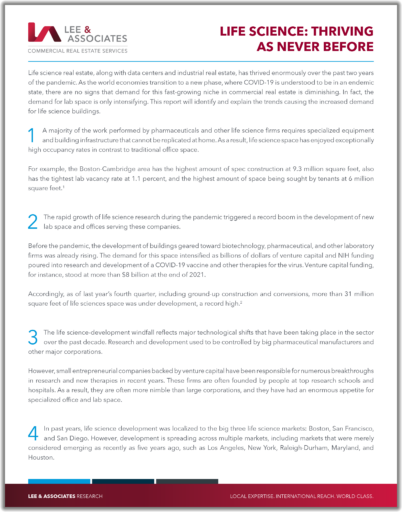Life Science: Thriving as Never Before
 Life science real estate, along with data centers and industrial real estate, has thrived enormously over the past two years of the pandemic. As the world economies transition to a new phase, where COVID-19 is understood to be in an endemic state, there are no signs that demand for this fast-growing niche in commercial real estate is diminishing. In fact, the demand for lab space is only intensifying. This report will identify and explain the trends causing the increased demand for life science buildings.
Life science real estate, along with data centers and industrial real estate, has thrived enormously over the past two years of the pandemic. As the world economies transition to a new phase, where COVID-19 is understood to be in an endemic state, there are no signs that demand for this fast-growing niche in commercial real estate is diminishing. In fact, the demand for lab space is only intensifying. This report will identify and explain the trends causing the increased demand for life science buildings.
1 A majority of the work performed by pharmaceuticals and other life science firms requires specialized equipment and building infrastructure that cannot be replicated at home. As a result, life science space has enjoyed exceptionally high occupancy rates in contrast to traditional office space.
For example, the Boston-Cambridge area has the highest amount of spec construction at 9.3 million square feet, also has the tightest lab vacancy rate at 1.1 percent, and the highest amount of space being sought by tenants at 6 million square feet.1
2 The rapid growth of life science research during the pandemic triggered a record boom in the development of new lab space and offices serving these companies.
Before the pandemic, the development of buildings geared toward biotechnology, pharmaceutical, and other laboratory firms was already rising. The demand for this space intensified as billions of dollars of venture capital and NIH funding poured into research and development of a COVID-19 vaccine and other therapies for the virus. Venture capital funding, for instance, stood at more than $8 billion at the end of 2021.
Accordingly, as of last year’s fourth quarter, including ground-up construction and conversions, more than 31 million square feet of life sciences space was under development, a record high.2
3 The life science-development windfall reflects major technological shifts that have been taking place in the sector over the past decade. Research and development used to be controlled by big pharmaceutical manufacturers and other major corporations.
However, small entrepreneurial companies backed by venture capital have been responsible for numerous breakthroughs in research and new therapies in recent years. These firms are often founded by people at top research schools and hospitals. As a result, they are often more nimble than large corporations, and they have had an enormous appetite for specialized office and lab space. READ MORE >
